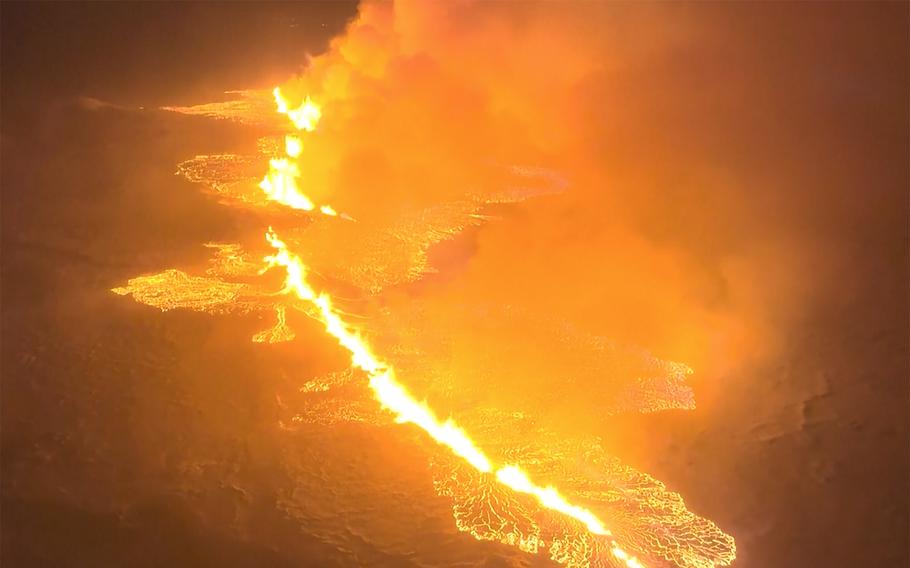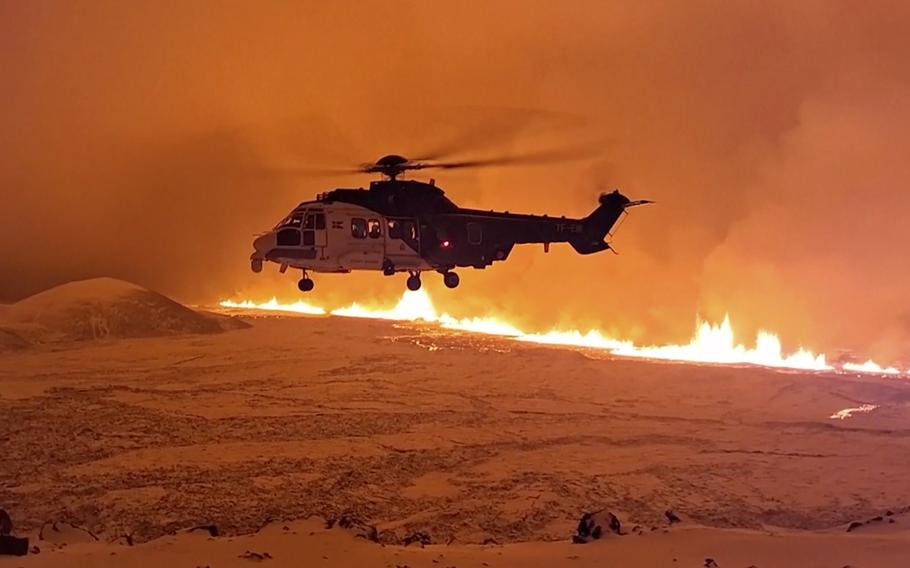Europe
Iceland volcano eruption underway, meteorological office reports
The Washington Post December 19, 2023

Magma flows on a hill near Grindavik on Iceland's Reykjanes Peninsula following a volcanic eruption on Dec. 18. (Icelandic Coast Guard)
A volcanic eruption is underway in southwestern Iceland, with magma breaching the surface north of the town of Grindavik, the country’s meteorological office said Monday evening.
In live-streamed footage of the eruption, plumes of red smoke billow up from scorching white lava — all cast against the pitch-black Icelandic night.
The meteorological office said an “earthquake storm” on the Reykjanes Peninsula preceded the eruption, which began about 10:15 p.m. local time about 2½ miles northeast of Grindavik. Coast guard authorities were investigating.
Police ordered the nearly 4,000 residents of Grindavik to leave on Nov. 10, after scientific measurements determined that a tunnel of magma had extended underneath the coastal town. Grindavik is not far from Iceland’s famous Blue Lagoon geothermal spa resort, which has been closed as a safety precaution.
The lava appeared to be moving north, away from Grindavik, according to an X post from the Lava Centre museum.
It isn’t clear how much damage the eruption will cause, Icelandic President Gudni Thorlacius Johannesson posted on Facebook. He said his priority is to save human life, but authorities would do all they could to protect structures.
Iceland — nicknamed the Land of Fire and Ice — is a hot spot for volcanic activity thanks to its position over tectonic plates that are moving in opposite directions, allowing magma to rise. The country has more than 30 active volcanic systems.
But this was the first time in half a century that a sizable populated area had to be fully evacuated in anticipation of an eruption. The long-gestating threat of eruption raised fears of destructive lava flows, though scientists played down the potential for significant disruption of global travel or a decrease in air quality in the Northern Hemisphere.
Magma shifting under Earth’s crust had produced tens of thousands of earthquakes in the area in October and November, damaging buildings and splitting open roads, leaving some impassable.
Exactly where the volcanic system might erupt had been a matter of uncertainty — and high anxiety. This one was not what people might think of as a stereotypical volcano: a conical mountain spewing lava. It involved a stealthier, more unpredictable subterranean flow of magma, tunneling below the Reykjanes Peninsula, slowly pushing its way toward the surface.
“All volcanoes are kind of humbling, but a volcano that appears whenever it wants to is really humbling,” Robin Andrews, a volcanologist, science writer and author of the book “Super Volcanoes,” said before Monday’s eruption. “We might think we are all mighty and powerful, but we can’t predict what will happen, and when it does, we just have to deal with it. These fissures can just open up. It’s crazy. It’s like sorcery or something.”
Andrews later described the Iceland eruption fissure as a “beast.”
Magnús Tumi Guðmundsson, a professor of geophysics at the University of Iceland, said the main worries had been that the lava could flow over parts of Grindavik and even reach the Svartsengi geothermal power plant, which supplies electricity and supports home heating for about 30,000 people. The plant is now being run remotely.
“There could be quite some disruption and a lot of damage,” Guðmundsson said ahead of the eruption. “It’s quite serious when you have to evacuate 3,700 people and you don’t know when they can return.”
Bryndis Gunnlaugsdottir, 42, a lawyer and former head of the Grindavik city council, described her town as “fiercely proud” and “very worried.”
“There are all of these financial worries,” she said. “But also, ‘Will my town still be there?’ Our feelings are all over the place.”
Although the town was known to be in a seismically active area — the nearby Fagradalsfjall volcano has erupted in each of the past three years — she said residents were surprised when underground lava was detected so close. “In all scenarios that have been drawn up over the years, the volcano was always supposed to erupt around us, but not in town. We have never felt that our house might not be there,” she said.
Still, she said that many residents have long had personal evacuation plans. Hers involved preparing a “memory box” of sentimental items, including photographs of her parents, trophies and drawings from kindergarten. On the evening of Nov. 10, after “constant earthquakes, so many you could hardly stand,” she grabbed the box from the garage and left town.
“Icelanders are so fully aware of the dynamic and changing volcanic nature of their country, every single person knows what’s going on,” Andrews said. “Often you see during disasters it takes a lot to convince people to leave their homes. But authorities here didn’t need to convince people to leave — everyone gets it, no one needs pandering to. It’s a relief.”

An Icelandic Coast Guard helicopter flies near magma running on a hill near Grindavik on Iceland's Reykjanes Peninsula following a volcanic eruption on Dec. 18. (Icelandic Coast Guard)
All of Grindavik was evacuated by the early hours of Nov. 11. As the wait dragged on, residents were allowed back in briefly to gather belongings, including pets left behind in the rush to leave. An animal rescue organization also worked to evacuate pets.
Before the eruption, volcano experts said the event probably would not replicate the disruption caused by Iceland’s Eyjafjallajokull volcano in 2010, when a huge plume of ash dispersed over Europe and wreaked havoc on global air travel for weeks. That volcano produced a high volume of fine ash in part because of how the erupting magma interacted with an ice cap. But there is no ice cap in this case.
Ahead of this eruption, experts warned there could still be some disruption to aviation, and they didn’t discount the risk of drifting clouds of toxic fumes, especially for those downwind. In 1783, the Laki volcanic system belched out poisonous gases that led to the death of over half of Iceland’s livestock and caused a famine.
Guðmundsson said this eruption could be more serious than the recent Fagradalsfjall eruptions, which attracted volcano tourism. Kaleo, an Icelandic band, performed a live acoustic show in 2021 with the lava spewing in the background.
This eruption “is not considered tourist-friendly,” Guðmundsson said. “This could be lava flowing and destroying infrastructure and houses.”
News agencies installed webcams on nearby volcanic hills so people could watch the eruption.